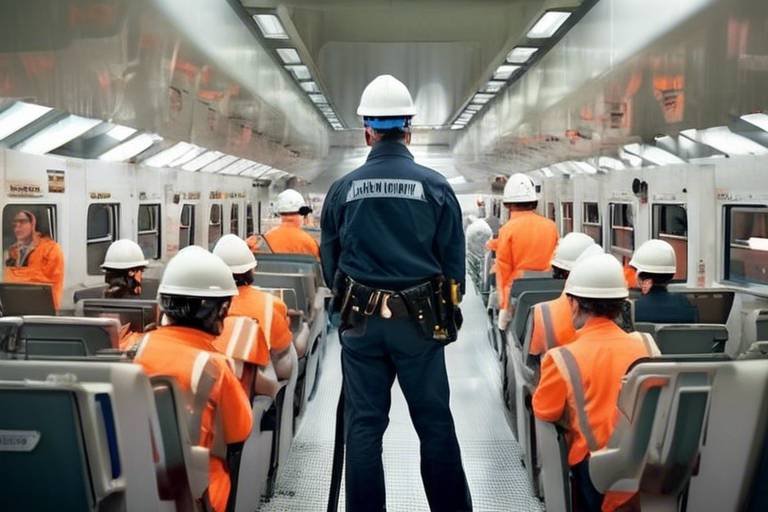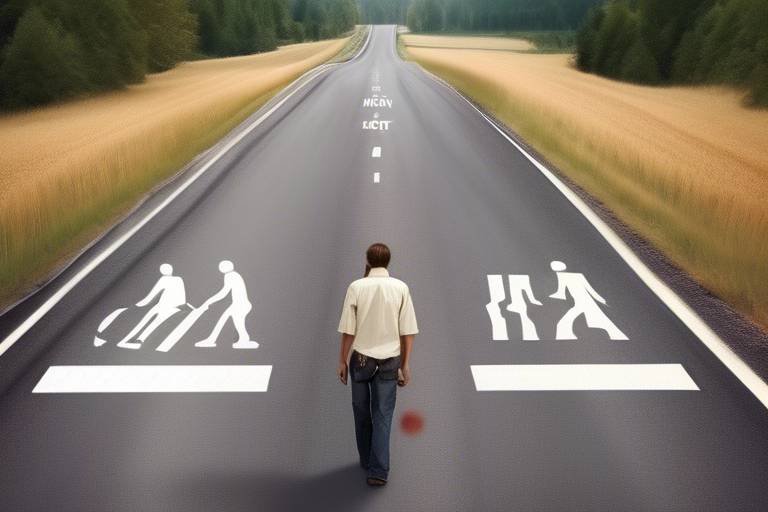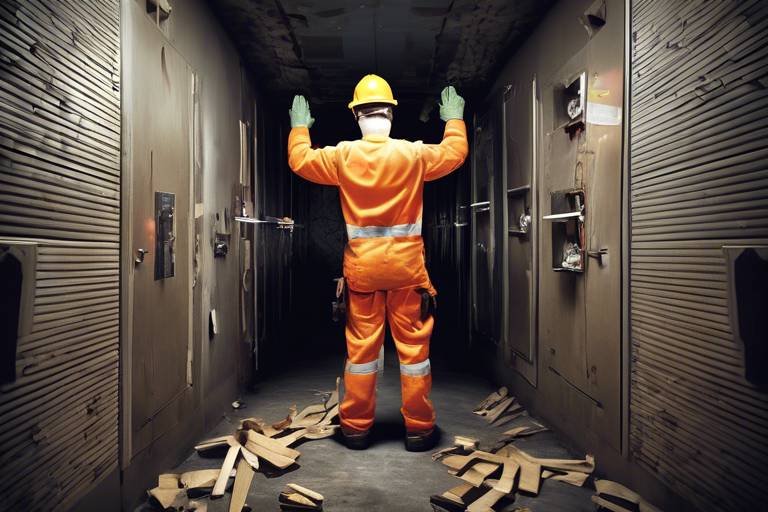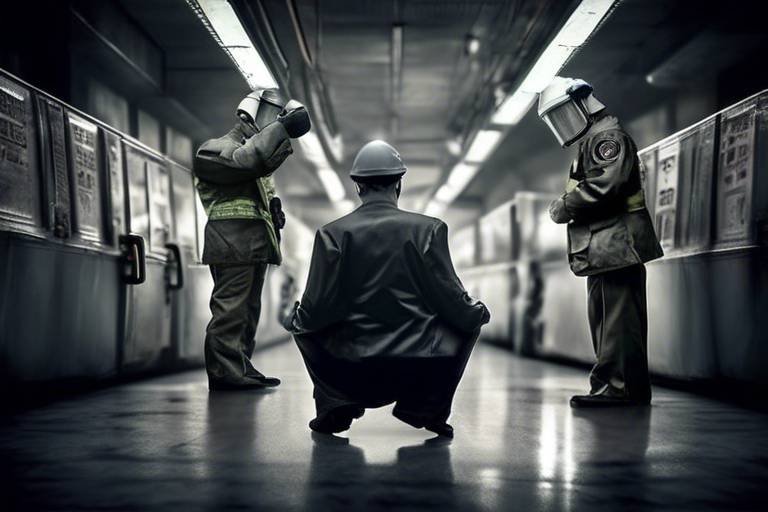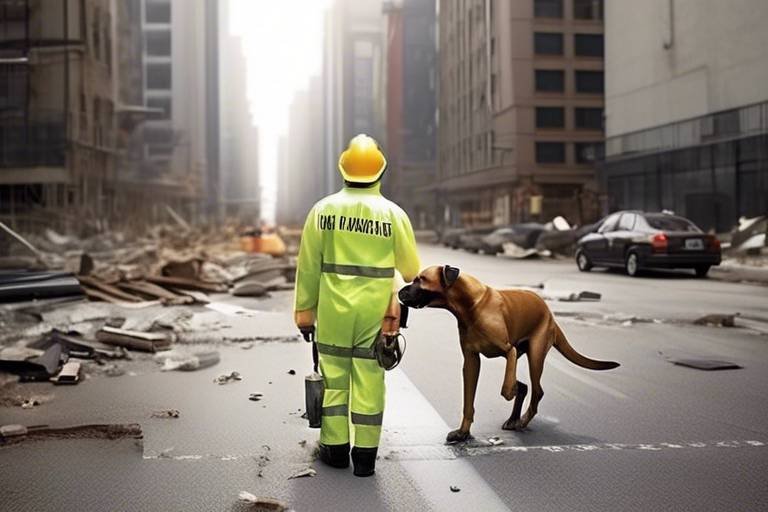The Influence of Human Behavior on the Perception of Safety
In our daily lives, the concept of safety often feels like a delicate balancing act, influenced by a myriad of factors that stem from our behavior and experiences. It's fascinating how our psychological makeup, the people we surround ourselves with, and even the environments we inhabit can shape our perception of safety. Imagine walking down a bustling city street; the sounds, the crowd, and the atmosphere can either make you feel secure or on edge. This article dives deep into the intricate ways human behavior molds our understanding of safety, examining the psychological factors, social influences, and environmental elements that contribute to our sense of security.
Our minds are powerful tools, and they often filter our experiences through a lens colored by past traumas, innate fears, and various cognitive biases. For instance, if someone has had a negative experience in a specific location, their perception of safety in that area may be permanently altered. This is known as the availability heuristic, where individuals assess the likelihood of an event based on how easily they can recall similar instances. It's almost like carrying a shadow of fear that lingers long after the initial event. Understanding these psychological factors is crucial because they can distort our perception of risk and security, leading to either unnecessary anxiety or a false sense of invulnerability.
Have you ever noticed how your feelings about a situation can shift based on the reactions of those around you? This is the essence of social influence, where our perceptions of safety can be significantly swayed by the opinions and behaviors of peers and authority figures. When we see others reacting with fear or caution, it can trigger a similar response within us. This phenomenon is particularly evident in group settings, where collective behavior can amplify fears or create a comforting bubble of security. For example, during a community safety meeting, if the majority express concerns about local crime rates, even those who felt safe may start to question their own feelings.
Group dynamics can create a powerful ripple effect on how safety is perceived. When individuals come together, their collective behaviors can lead to heightened fears or, conversely, a false sense of security. Think of it like a group of friends walking home at night; if one person feels anxious, that anxiety can spread, influencing the entire group's perception of their safety. This is where the bandwagon effect comes into play, where people adopt certain behaviors or beliefs simply because others do. It’s essential to recognize this influence, as it can lead to irrational safety perceptions that may not align with reality.
Conformity can be a double-edged sword when it comes to safety perceptions. Individuals often feel pressured to align their views with the majority, even if those perceptions are unfounded. For instance, if everyone in a neighborhood believes that a certain area is dangerous, newcomers might adopt that belief without any personal experience to back it up. This can create an echo chamber of fear that distorts the actual safety of the environment. It's crucial to challenge these conformist tendencies and encourage critical thinking about safety perceptions.
Effective communication about risks within social groups can either enhance or diminish the collective perception of safety. Clear messaging is vital; if misinformation spreads within a group, it can lead to unnecessary panic or complacency. For example, if a rumor circulates about a spike in local crime without proper context, it can instill fear that may not be justified. On the other hand, transparent communication about safety measures can foster a sense of security and community trust. Thus, the way we talk about risks can significantly influence how safe we feel.
Just as no two fingerprints are alike, no two individuals perceive safety in the same way. Personal traits, such as risk tolerance and past experiences, lead to significant variations in how people respond to safety concerns. Some individuals may thrive in high-risk environments, feeling invigorated by the thrill, while others may feel paralyzed by fear in similar situations. This diversity in perception underscores the importance of understanding that safety is not a one-size-fits-all experience. Factors such as upbringing, personal beliefs, and even cultural backgrounds play a significant role in shaping our individual responses to perceived threats.
The physical environment we inhabit is another critical player in shaping our perceptions of safety. Urban areas, with their bustling streets and higher crime rates, often evoke different feelings compared to the tranquility of rural settings. The design of a neighborhood can either promote a sense of security or instill fear. For instance, well-lit streets and visible community engagement can enhance safety perceptions, while dark alleys and neglected spaces can heighten anxiety. Understanding these environmental factors can help us make informed decisions about our surroundings and how we navigate them.
Urban and rural settings can lead to contrasting perceptions of safety, driven by factors such as crime rates, community cohesion, and environmental design. In urban areas, the presence of more people and activities can create a sense of vibrancy but also increases the likelihood of crime. Conversely, rural areas may have lower crime rates, but the isolation can lead to a different set of safety concerns, such as emergency response times. This dichotomy highlights the need for tailored safety strategies that consider the unique characteristics of each environment.
In our tech-savvy world, advancements in technology have dramatically transformed how we perceive safety. Tools like surveillance cameras, mobile apps, and social media provide new ways to assess and respond to risks in real time. For instance, neighborhood watch apps allow residents to share information about suspicious activities, fostering a sense of community vigilance. However, this reliance on technology can also lead to heightened anxiety, as constant notifications about potential threats can create a feeling of being perpetually on guard. It's a fine line between empowerment and paranoia, and understanding this balance is crucial for navigating safety in the digital age.
- How do personal experiences shape our perception of safety? Personal experiences, especially negative ones, can create lasting impressions that alter how we perceive safety in similar situations.
- What role does social influence play in safety perceptions? Social dynamics can significantly impact our views on safety, as we often adjust our beliefs based on the reactions of those around us.
- How can technology improve our sense of safety? Technology, such as surveillance systems and safety apps, can enhance our awareness and response to potential risks, although it can also contribute to anxiety.

Psychological Factors Affecting Safety Perception
When it comes to safety, our minds can play tricks on us. The way we perceive safety is often a reflection of our psychological makeup, influenced by a myriad of factors including our past experiences, inherent fears, and cognitive biases. Think of it like wearing tinted glasses: the color of those lenses can dramatically alter how we see the world around us. For instance, someone who has experienced a traumatic event may view certain situations as more dangerous than they actually are, leading to an exaggerated sense of risk.
One of the most fascinating aspects of safety perception is the role of cognitive biases. These are mental shortcuts our brains take to simplify complex information. For example, the availability heuristic is a common bias where people judge the likelihood of an event based on how easily they can recall similar instances. If someone frequently hears about violent crimes in their neighborhood, they may overestimate the actual risk, feeling unsafe even in otherwise secure environments. This can create a cycle of anxiety that affects their everyday life.
Moreover, our emotional responses to situations can cloud our judgment. Fear is a powerful emotion that can trigger a fight-or-flight response, often leading to irrational decisions. Imagine walking alone at night; if you hear a rustling in the bushes, your heart might race, and your mind might conjure up worst-case scenarios. This heightened state of alertness can skew your perception of safety, making you feel more vulnerable than you actually are.
Now, let's not forget about social learning. We often look to others when assessing our environment. If friends or family express fear about a particular situation, we're likely to adopt similar feelings, even if there's no objective basis for that fear. This phenomenon is particularly evident in communities where fear can spread like wildfire, leading to a collective anxiety that may not align with actual safety statistics.
In summary, the perception of safety is not just about the external environment; it is deeply rooted in our psychological state. Our past experiences, cognitive biases, emotional responses, and social influences all converge to shape how we interpret the world around us. Understanding these factors can help us navigate our feelings of safety more effectively, allowing us to make more informed decisions about our environments.
- What are cognitive biases? Cognitive biases are systematic patterns of deviation from norm or rationality in judgment, which can affect our perception of safety.
- How do past experiences influence safety perception? Past experiences, especially traumatic ones, can lead to heightened fears and a skewed sense of risk in similar situations.
- Can social influences change how we feel about safety? Yes, social influences, including the opinions and behaviors of those around us, can significantly shape our perceptions of safety.
- What role do emotions play in safety perception? Emotions like fear can lead to irrational decisions and an exaggerated sense of danger, affecting our overall perception of safety.

The Role of Social Influence
Social dynamics play a crucial role in shaping our perceptions of safety. Have you ever noticed how your feelings about a neighborhood can change based on what your friends or family say? It's fascinating how opinions can sway our judgments, often leading us to adjust our views based on the behaviors and attitudes of those around us. This phenomenon is particularly evident in various social settings, where the collective mindset can either bolster a sense of security or amplify fears.
When we consider the impact of social influence, we realize that it operates on multiple levels. For instance, peer pressure can lead individuals to adopt certain safety behaviors, whether it's avoiding a particular area or engaging in precautionary measures. This can create a ripple effect, where one person's fear can quickly spread to others, altering the group's overall perception of safety. The power of suggestion is strong; just as a single person can express concern about safety, that sentiment can grow and morph into a widespread belief, even if the initial fear was unfounded.
Group dynamics significantly impact how safety is perceived, often leading to heightened fears or a false sense of security. Imagine a group of friends discussing their experiences in a supposedly "dangerous" part of town. If one person shares a story of a negative encounter, it can trigger a wave of anxiety among the others, even if their own experiences have been positive. This collective behavior can skew their perception, making them believe that the area is more hazardous than it truly is.
Conversely, in situations where a group feels safe, such as a community event or a public gathering, individuals may let their guard down. This can create a false sense of security, where people feel invulnerable to risks that they would normally be cautious about. It's this duality of group behavior that highlights the intricate relationship between social influence and safety perception.
Conformity pressures can lead individuals to adopt safety perceptions that align with the majority, even if those perceptions are irrational or unfounded. Think about it: when you're in a crowd, how often do you find yourself looking around to gauge the reactions of others? If everyone seems relaxed, you're likely to feel safe too. However, if there's a hint of panic or concern, you might find yourself feeling anxious, regardless of your personal assessment of the situation.
This tendency to conform can have significant implications for decision-making. For example, if a group decides to avoid a certain area due to safety concerns, even if those concerns are based on outdated information, individuals may follow suit without questioning the validity of the fears. This can lead to entire communities being unfairly labeled as unsafe, affecting local businesses and residents.
Effective communication about risks within social groups can either enhance or diminish the collective perception of safety. Clear and accurate messaging is essential. If a community leader communicates potential risks in a calm and informative manner, it can help individuals make informed decisions without succumbing to panic. On the other hand, sensationalized or vague communication can create unnecessary fear, leading to a heightened sense of danger.
To illustrate this point, consider the following table that outlines the effects of different communication styles on safety perceptions:
| Communication Style | Effect on Safety Perception |
|---|---|
| Clear and Informative | Reduces anxiety, promotes informed decision-making |
| Sensationalized | Increases fear, leads to irrational behaviors |
| Vague | Creates uncertainty, heightens anxiety |
In summary, social influence is a powerful force that shapes our perceptions of safety. From group dynamics to conformity pressures, our understanding of risk is often colored by the opinions and behaviors of those around us. As we navigate through life, it’s essential to be aware of these influences and strive for clear communication to foster a more accurate understanding of safety in our communities.
- How does social influence affect individual safety perceptions?
Social influence can lead individuals to adopt the safety perceptions of their peers, often resulting in heightened fears or a false sense of security. - What role does communication play in shaping safety perceptions?
Effective communication can either alleviate fears or exacerbate them, depending on how risks are conveyed within social groups. - Can group behavior lead to irrational safety decisions?
Yes, group dynamics can lead individuals to conform to the majority's views, even if those views are not based on factual information.

Group Behavior and Safety
When it comes to safety, the power of group behavior cannot be underestimated. Think about it: have you ever noticed how your feelings of safety can shift depending on who you're with? It's not just in your head; it's a psychological phenomenon deeply rooted in human nature. When we find ourselves in a group, our perceptions can be heavily influenced by the collective mindset. This can lead to heightened fears or, conversely, a false sense of security. For instance, if you're walking through a dimly lit street and you’re alone, you might feel anxious. But if you’re with a group of friends, that same street may suddenly feel less threatening. This shift in perception illustrates how our safety is often a reflection of the people we surround ourselves with.
Group dynamics play a significant role in shaping our understanding of safety. When individuals come together, their collective behavior can create a unique atmosphere that affects everyone involved. Imagine a scenario where a group of friends is hiking in the wilderness. If one person expresses fear about a potential bear sighting, it can quickly spread to the others, amplifying anxiety even if the group was initially calm. This phenomenon is known as contagion effect, where emotions, including fear, can ripple through a group, heightening collective concern.
Moreover, conformity is another crucial aspect of group behavior that influences safety perceptions. People often feel pressure to align their views with the majority, even if those views are irrational. For example, if a group decides that a certain area is unsafe based purely on rumors, individuals may adopt that belief without assessing the actual risks involved. This can lead to unnecessary panic or avoidance behaviors that might not be warranted. The challenge lies in balancing individual judgment with the influence of the group—how do we trust our instincts when everyone around us seems to feel differently?
Effective communication within groups is essential for maintaining a clear understanding of safety risks. When members of a group share information about potential dangers, it can either enhance or diminish the overall perception of safety. For instance, if a community organizes a safety meeting to discuss local crime rates and preventive measures, it can foster a sense of empowerment among residents. They feel informed and capable of taking action, which can significantly improve their sense of security. However, poor communication can lead to misunderstandings and heightened fears, making it vital for groups to communicate transparently and effectively.
In conclusion, group behavior significantly impacts our perceptions of safety. Whether it leads to increased fears or a false sense of security, understanding these dynamics is crucial for navigating our environments. The next time you find yourself in a group, consider how the collective mindset might be influencing your feelings of safety. Are you feeling more secure because of the presence of others, or are you simply conforming to the group's fears? These reflections can help you better understand the intricate relationship between group behavior and safety perceptions.
- How does group behavior influence individual safety perceptions?
Group behavior can amplify or diminish individual feelings of safety based on collective attitudes and emotions. - What is the contagion effect in group settings?
The contagion effect refers to the phenomenon where emotions, such as fear, spread through a group, affecting the perceptions and behaviors of its members. - Why is effective communication important in groups regarding safety?
Clear communication helps to inform group members about risks and can empower them to take appropriate actions, thereby enhancing their sense of security. - How can conformity impact safety decisions?
Conformity can lead individuals to adopt safety perceptions that align with the majority, even if those perceptions are irrational or unfounded.

Conformity and Safety Decisions
Conformity is a powerful force in shaping how we perceive safety, often leading us to make decisions based on the beliefs and behaviors of those around us rather than on our own judgment. Think about it: when you're in a group, whether it's friends at a party or colleagues in a meeting, there's an unspoken pressure to align your views with the majority. This can create a false sense of security where individuals may ignore their instincts or valid concerns simply because everyone else seems unbothered. For instance, if a group of friends decides to walk through a dimly lit park at night, one might feel hesitant but ultimately go along with the group, believing that their collective presence somehow diminishes the risk.
This phenomenon can be particularly dangerous in situations where safety is at stake. When individuals conform to the beliefs of the majority, they may overlook critical information or warnings. For example, if a group is discussing the safety of a neighborhood and most people express confidence in its security, a person who has reservations might suppress their concerns, thinking, "If everyone else feels safe, I should too." This mindset can lead to risky behaviors and decisions that compromise not just personal safety but also the safety of the entire group.
Moreover, the impact of conformity on safety decisions can vary based on the context and the individuals involved. In high-stakes environments, such as emergency situations, the pressure to conform can escalate, leading to chaotic decision-making. People might follow the crowd even when it contradicts their better judgment, which can have dire consequences. Understanding this dynamic is crucial because it highlights the importance of fostering an environment where individuals feel empowered to voice their concerns without fear of judgment.
To mitigate the effects of conformity on safety decisions, it’s essential to encourage open dialogue and critical thinking within groups. Here are a few strategies that can help:
- Promote Individual Responsibility: Encourage group members to share their personal assessments of safety without feeling pressured to conform.
- Foster a Culture of Questioning: Create an environment where asking questions and expressing doubts is welcomed and valued.
- Educate on Risk Awareness: Provide information on how to assess risks independently, empowering individuals to make informed decisions.
By understanding the influence of conformity on safety perceptions, we can take proactive steps to ensure that group dynamics enhance rather than hinder our collective sense of security. It's about striking a balance between valuing group consensus and respecting individual instincts, ultimately leading to safer environments for everyone involved.
Q1: What is conformity in the context of safety decisions?
A1: Conformity refers to the tendency of individuals to align their beliefs and behaviors with those of a group, which can influence their perceptions of safety and lead to decisions that may not reflect their true feelings or instincts.
Q2: How can I resist the pressure to conform in safety situations?
A2: To resist conformity, it's important to trust your instincts, seek information independently, and communicate openly with others about your concerns. Building a culture of questioning within your group can also help.
Q3: Can conformity ever have positive effects on safety?
A3: Yes, in some cases, conformity can lead to positive safety behaviors, such as when a group collectively adopts safety protocols or encourages each other to adhere to safety guidelines. However, it’s crucial that these behaviors are based on informed decisions rather than blind adherence to group norms.

Risk Communication in Social Settings
When it comes to understanding safety, effective communication about risks in social settings can be a game changer. Imagine you're in a crowded room, and someone shouts that there's a fire. How do you react? Your response is influenced by the messages you receive, the credibility of the source, and the behavior of those around you. If your friends remain calm, you might think, "Maybe it's not as serious as it sounds." Conversely, if panic ensues, you might find yourself swept up in the chaos, regardless of the actual danger.
In social settings, the way information is conveyed can either enhance or diminish the collective perception of safety. For instance, if a community leader communicates a potential threat, their authority can lend weight to the message, making people more likely to take it seriously. On the other hand, if the same message comes from someone perceived as unreliable, it may be dismissed, leading to a false sense of security. This highlights the importance of clear and credible messaging.
Moreover, the medium through which risk communication occurs plays a crucial role. In today’s digital age, social media can spread information rapidly, but it can also lead to misinformation. A single tweet can ignite fear, regardless of its accuracy. Therefore, it’s vital for individuals to critically assess the information they receive and consider the source before reacting. This is especially true in high-stress situations where emotions can cloud judgment.
To illustrate the impact of risk communication, consider the following table that summarizes key elements that affect how safety messages are perceived:
| Element | Impact on Perception |
|---|---|
| Source Credibility | High credibility enhances trust and compliance; low credibility leads to skepticism. |
| Message Clarity | Clear messages lead to better understanding; vague messages create confusion. |
| Medium of Communication | Traditional media may be trusted more than social media, affecting response rates. |
| Group Dynamics | Peer reactions can amplify or diminish perceived threat levels. |
In summary, the interplay between risk communication and social settings is complex yet vital for our understanding of safety. By fostering an environment where clear, credible, and calm communication is prioritized, communities can navigate risks more effectively. Ultimately, being aware of how messages are framed and received can empower individuals to make informed decisions about their safety and the safety of those around them.

Individual Differences in Safety Perception
When it comes to safety, not everyone sees the world through the same lens. Our individual differences play a critical role in how we perceive safety and respond to potential threats. Think about it: two people can walk down the same street, but one might feel completely secure while the other is on high alert. This discrepancy is influenced by a myriad of factors, including personal traits, experiences, and even cultural backgrounds.
One of the most significant factors affecting safety perception is risk tolerance. Some individuals are naturally more inclined to take risks, viewing certain situations as less threatening. For instance, someone who enjoys extreme sports may perceive a high level of risk as an exciting challenge rather than a danger. In contrast, a more cautious person may see even a minor risk as a potential catastrophe. This difference in risk tolerance can lead to varying responses in similar situations, such as avoiding certain neighborhoods or activities based solely on personal comfort levels.
Another crucial element is past experiences. If someone has had a negative encounter, like a robbery or an accident, that memory can cast a long shadow over their perception of safety. They might become hyper-aware in similar environments, constantly scanning for signs of danger. Conversely, individuals with positive experiences may develop a more relaxed attitude towards their surroundings, feeling secure even in places where others might be apprehensive. This phenomenon can be likened to the way a child learns to ride a bike; one fall can instill a fear that lasts a lifetime, while another child might hop back on without a second thought.
Moreover, cultural influences can also shape our understanding of safety. Different cultures have varying norms and values that dictate what is considered safe or unsafe. For instance, in some cultures, community cohesion and trust among neighbors can foster a sense of security, while in others, a more individualistic approach may lead to heightened feelings of vulnerability. Understanding these cultural nuances is essential, as they can significantly affect how safety is perceived and prioritized within different groups.
To illustrate these individual differences further, consider the following table that outlines various factors influencing safety perception:
| Factor | Description | Impact on Safety Perception |
|---|---|---|
| Risk Tolerance | Individual's willingness to engage in risky behaviors | Higher tolerance may lead to a more relaxed perception of danger |
| Past Experiences | Previous encounters with danger or safety | Negative experiences can heighten fear; positive experiences can lower it |
| Cultural Background | Norms and values that shape perceptions of safety | Varies widely; can either enhance or diminish feelings of security |
In conclusion, understanding individual differences in safety perception is crucial for creating environments that foster security for everyone. By recognizing that each person's background, experiences, and personality play a role in how they view safety, we can better address concerns and develop strategies that accommodate diverse perspectives. This awareness is not just beneficial for individuals but is also vital for communities aiming to enhance overall safety and well-being.
- What factors influence individual differences in safety perception? Individual differences are influenced by risk tolerance, past experiences, and cultural backgrounds.
- How do past experiences shape our perception of safety? Negative encounters can lead to heightened fear, while positive experiences can foster a sense of security.
- Can cultural background affect how we perceive safety? Yes, different cultures have varying norms that can significantly impact feelings of safety and security.

Environmental Factors and Safety
The physical environment plays a pivotal role in shaping our perceptions of safety, influencing how we assess risks and make decisions regarding our well-being. Think about it: when you walk through a dimly lit alleyway, your heart races, and your mind fills with scenarios of danger. This visceral reaction illustrates how our surroundings can trigger feelings of vulnerability or security. The design of our environments—be it urban or rural—can either enhance our sense of safety or amplify our fears.
For instance, urban areas often present a complex landscape of safety perceptions. High population density, mixed with varying crime rates, can create an atmosphere of anxiety. The constant hustle and bustle might suggest a vibrant community, but it can also lead to feelings of isolation. In contrast, rural areas, often perceived as safer, can have their own unique challenges. Limited access to emergency services and fewer people around can create a false sense of security. This contrast is not just about location; it’s about how our environments are structured and how they influence our daily lives.
Moreover, environmental design plays a crucial role in safety perception. Well-lit streets, visible security measures, and open spaces can enhance feelings of safety, while neglected areas, poor maintenance, and lack of community engagement can breed fear. For example, a neighborhood with well-kept parks and active community watch programs fosters a sense of security among its residents. On the other hand, areas with abandoned buildings and minimal social interaction can lead to heightened anxiety and a belief that danger lurks around every corner.
As we navigate through our environments, our perceptions of safety are also shaped by the presence or absence of certain elements. Here are a few environmental factors that can significantly impact our sense of safety:
- Lighting: Well-lit areas are generally perceived as safer than dark, poorly lit ones.
- Visibility: Open spaces with clear sightlines reduce feelings of vulnerability.
- Maintenance: Clean and well-maintained environments promote a sense of care and security.
- Community Engagement: Active participation in neighborhood watch programs can enhance feelings of safety.
Furthermore, advancements in technology have transformed how we interact with our environments and perceive safety. With the introduction of surveillance systems, mobile safety apps, and real-time alerts, individuals are more informed than ever about their surroundings. These tools not only provide an immediate sense of security but also empower individuals to take proactive measures in ensuring their safety.
In conclusion, the interplay between environmental factors and safety perception is complex and multifaceted. Understanding how our surroundings shape our feelings of security can help us create safer communities and improve our overall quality of life. By recognizing the influence of environmental design and technology, we can work towards fostering environments that promote safety and well-being for all.
Q: How do urban environments affect safety perceptions?
A: Urban environments can create a mix of safety perceptions due to high population density and varying crime rates. Well-designed urban spaces with good lighting and community engagement can enhance feelings of safety.
Q: What role does technology play in safety awareness?
A: Technology, such as surveillance systems and safety apps, has transformed how individuals perceive and respond to risks, providing real-time information that can enhance personal safety.
Q: Can community involvement improve safety perceptions?
A: Yes, active community involvement, such as neighborhood watch programs, can significantly enhance the collective perception of safety, fostering a sense of security among residents.

Urban vs. Rural Safety Perceptions
When we think about safety, our minds often drift to the environments we inhabit, and this is where the contrast between urban and rural areas becomes strikingly apparent. Urban safety perceptions are frequently shaped by the hustle and bustle of city life, where crime rates may be higher, but so too are the resources for safety such as police presence and community programs. In cities, individuals often feel vulnerable due to the density of people and the anonymity it brings. This can create a heightened sense of fear, where the perception of danger looms large, even if statistical evidence might suggest otherwise. For instance, a person walking alone at night in a city might feel more anxious than someone doing the same in a rural area, despite the actual crime rates being similar.
Conversely, in rural settings, the landscape is often perceived as more serene and secure. The community bonds are typically tighter, and people may feel a greater sense of familiarity with their neighbors. This can foster a feeling of safety, yet it can also lead to complacency. In rural areas, the perception of safety might be inflated due to the lower crime rates, which can sometimes result in a lack of preparedness for potential risks. Imagine a small-town resident who leaves their doors unlocked, believing that crime is a distant concern; this can create a false sense of security that may not hold up in the face of unexpected events.
Interestingly, the differences in safety perceptions can also be attributed to the design of the environment. Urban areas are often filled with tall buildings, busy streets, and less open space, which can create feelings of entrapment or vulnerability. In contrast, rural areas, with their wide-open spaces and less congestion, can evoke a sense of freedom and safety. However, this can also mean that in the event of an emergency, help may be farther away, which can be a significant factor in how safety is perceived.
To illustrate this further, consider the following table that compares key factors influencing safety perceptions in urban versus rural environments:
| Factor | Urban Areas | Rural Areas |
|---|---|---|
| Crime Rates | Generally higher | Generally lower |
| Community Cohesion | Often less cohesive | Often more cohesive |
| Access to Emergency Services | More accessible | Less accessible |
| Environmental Design | Dense and complex | Open and simple |
In summary, while urban areas may present more immediate dangers, rural settings can create a deceptive sense of safety that may not always hold true. Both environments have unique attributes that influence how individuals perceive safety. Understanding these differences is crucial for developing effective safety strategies tailored to each setting, ultimately fostering a more secure environment for everyone.

Impact of Technology on Safety Awareness
In today's fast-paced world, technology has become a double-edged sword when it comes to safety awareness. On one hand, it empowers us with tools and resources that enhance our ability to assess and respond to potential risks. On the other hand, it can also lead to a false sense of security, making us complacent in our safety practices. Think about it: how many times have you felt safer simply because you have a smartphone in your pocket? It’s like having a superhero at your fingertips, ready to swoop in and save the day. But is that perception always accurate?
One of the most significant advancements in technology that has influenced safety awareness is the proliferation of surveillance systems. From home security cameras to public CCTV, these technologies provide real-time monitoring and can deter criminal activity. However, they also raise questions about privacy and the potential for misuse. For instance, while a camera might make you feel safer in your neighborhood, the knowledge that you are being watched can create a sense of unease. It’s a classic case of the paradox of safety: the very tools designed to protect us can also make us feel vulnerable.
Moreover, mobile applications have revolutionized how we perceive safety. Apps like Nextdoor or Citizen allow users to report incidents in real-time, creating a community-driven approach to safety awareness. Yet, the information shared can sometimes be exaggerated or misinterpreted, leading to heightened fears or unnecessary panic. This phenomenon can be likened to the age-old game of telephone, where the message distorts as it passes from one person to another. Thus, while technology can enhance our awareness, it is crucial to approach the information with a critical mindset.
Furthermore, advancements in personal safety devices, such as smartwatches with emergency features and personal alarms, have made it easier for individuals to seek help in threatening situations. These devices act as lifelines, providing comfort and assurance that help is just a button press away. However, the reliance on these gadgets can sometimes lead to overconfidence. People may feel invincible, believing that technology will always have their back, which can result in risky behavior. In essence, while technology can enhance our safety, it is essential to balance it with personal responsibility and situational awareness.
In conclusion, the impact of technology on safety awareness is profound and multifaceted. It has the potential to both empower and mislead us. As we navigate this tech-savvy landscape, it is vital to remain vigilant and informed, using technology as a tool rather than a crutch. After all, safety is not just about having the latest gadgets; it’s about cultivating a mindset that values awareness, responsibility, and community.
- How does technology improve safety awareness?
Technology provides real-time information, enhances communication, and offers tools for monitoring and reporting safety issues. - Can technology create a false sense of security?
Yes, reliance on technology can lead individuals to underestimate risks and engage in risky behavior, believing they are safer than they actually are. - What role do mobile apps play in safety awareness?
Mobile apps facilitate community engagement and real-time reporting of incidents, but the information shared can sometimes be exaggerated. - Are personal safety devices effective?
Personal safety devices can be effective tools for seeking help but should not replace personal awareness and responsibility.
Frequently Asked Questions
- What are the main psychological factors that influence our perception of safety?
Our perception of safety is largely shaped by psychological factors such as past experiences, fears, and cognitive biases. For instance, if someone has had a negative experience in a certain environment, they may perceive that space as unsafe, regardless of the actual risk involved. Cognitive biases can also distort our understanding of safety, leading us to overestimate certain dangers while underestimating others.
- How does social influence affect safety perceptions?
Social dynamics play a pivotal role in how we perceive safety. We often look to our peers and authority figures to gauge what is considered safe or risky. This can lead to conformity, where individuals adopt the safety perceptions of the majority, even if those views are irrational. Essentially, if everyone in a group feels a certain way about a risk, that collective belief can significantly alter individual perceptions.
- What role does group behavior play in safety perception?
Group behavior can amplify feelings of safety or fear. When people are part of a group, they might feel a heightened sense of security due to shared experiences or collective knowledge. Conversely, groupthink can lead to exaggerated fears, where individuals become overly cautious or paranoid about certain risks, simply because everyone else is.
- How do individual differences impact safety perceptions?
Individual differences such as personality traits, risk tolerance, and previous experiences can lead to significant variations in how safety is perceived. For example, someone who is more adventurous may perceive certain activities as safe, while a more cautious individual might view the same activities as risky. These personal traits shape how we assess and respond to safety concerns in our environments.
- What environmental factors influence our perception of safety?
The physical environment plays a crucial role in shaping our safety perceptions. Urban areas may be perceived as less safe due to higher crime rates, while rural areas might feel safer because of community cohesion. Additionally, environmental design—like well-lit streets or the presence of surveillance cameras—can either enhance or diminish feelings of safety.
- How does technology impact our awareness of safety?
Advancements in technology have significantly transformed how we perceive safety. Tools such as surveillance cameras, mobile safety apps, and social media updates provide real-time information about safety risks. This technology can empower individuals to make informed decisions about their safety, but it can also lead to anxiety if people become overly reliant on it or exposed to constant alerts about potential dangers.


